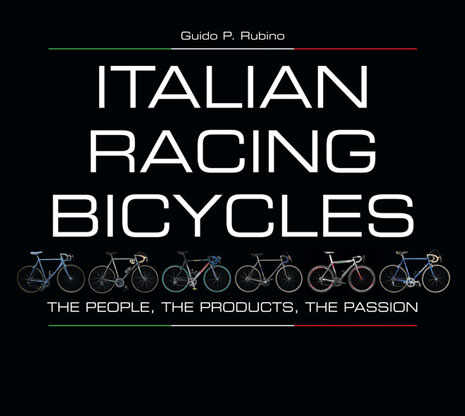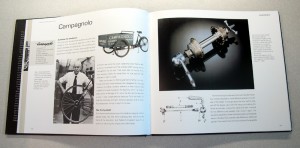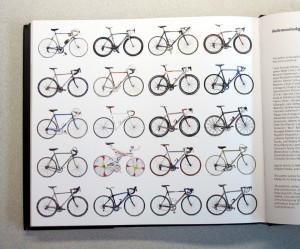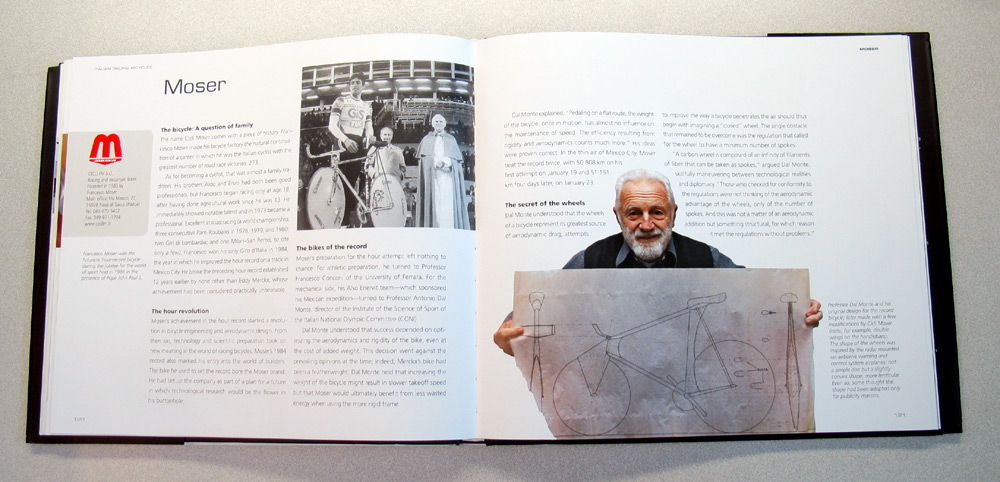 When I started to get serious about road riding and racing in the mid 80s, I bought a Suntour equipped Trek 500 (just like the one on the cover of the ’85 catalog). It was a fine bike, especially considering the fact that it cost less than 300 bucks, but from the first time I rode it I dreamed of someday upgrading to a lugged steel Italian bike. Cinelli, Gios, Pinarello, De Rosa, Masi, Colnago, Guerciotti, and Tommasini were the brands that I lusted after the most, and Campy C-record was the grouppo that I always aspired to own as I leafed through well worn magazines and catalogs day after day. Sometime in the late 80s, I got my first Italian bike, a Pinarello with Gipiemme components. My interest in (or obsession with) Italian bicycles continued for many years before I slowly transitioned to owning mostly Shimano equipped bikes from American brands like Cannondale, Klein, Litespeed, Trek (again), and Specialized. Except for the old lugged steel Marinoni that I still own (and technically that’s a Canadian bike), the Italian bikes are just memories for me now.
When I started to get serious about road riding and racing in the mid 80s, I bought a Suntour equipped Trek 500 (just like the one on the cover of the ’85 catalog). It was a fine bike, especially considering the fact that it cost less than 300 bucks, but from the first time I rode it I dreamed of someday upgrading to a lugged steel Italian bike. Cinelli, Gios, Pinarello, De Rosa, Masi, Colnago, Guerciotti, and Tommasini were the brands that I lusted after the most, and Campy C-record was the grouppo that I always aspired to own as I leafed through well worn magazines and catalogs day after day. Sometime in the late 80s, I got my first Italian bike, a Pinarello with Gipiemme components. My interest in (or obsession with) Italian bicycles continued for many years before I slowly transitioned to owning mostly Shimano equipped bikes from American brands like Cannondale, Klein, Litespeed, Trek (again), and Specialized. Except for the old lugged steel Marinoni that I still own (and technically that’s a Canadian bike), the Italian bikes are just memories for me now.
 Those memories immediately came flooding back when I started reading Italian Racing Bicycles: The People, The Products, The Passion by Guido Rubino. It is a beautiful 174 page hardcover coffee table book with hundreds of great photographs of Italian bikes and components from the turn of the century to today. It is much more than a nice looking coffee table book though. Sure, you could put it on display and only browse through it occasionally, but I would recommend reading it from cover to cover first. If you have an interest in Italian bicycles, you will enjoy the thorough background information about each of the 40 brands that are profiled in the book. The book features photographs of a few more modern bikes than I expected in each section, but overall I think the mix of old and new is well balanced. Each section starts with background information about the founder of the company, and follows the story through to the company’s present day operations. I had a rough idea about the origins of many of these companies, but I found much of the in-between history to be quite interesting; Campy making helicopter and satellite parts in the 70’s, Bianchi making Italian infantry bikes during World War I, or Wilier Triestina’s rebirth as a bicycle brand in the late 60’s after the factory had shifted to motorcycle manufacturing for nearly 20 years. It was also interesting to contrast the styles of the different companies. Brands like Cinelli, Moser, and later Bottecchia pushed the boundaries with innovative and experimental designs, while others built traditional steel frames that changed very little from decade to decade due to the fact that the geometries and techniques were shaped by many years of experience. Though the approaches were different, all of the brands are intertwined in the history of the Italian bicycle industry and the country’s rich racing heritage.
Those memories immediately came flooding back when I started reading Italian Racing Bicycles: The People, The Products, The Passion by Guido Rubino. It is a beautiful 174 page hardcover coffee table book with hundreds of great photographs of Italian bikes and components from the turn of the century to today. It is much more than a nice looking coffee table book though. Sure, you could put it on display and only browse through it occasionally, but I would recommend reading it from cover to cover first. If you have an interest in Italian bicycles, you will enjoy the thorough background information about each of the 40 brands that are profiled in the book. The book features photographs of a few more modern bikes than I expected in each section, but overall I think the mix of old and new is well balanced. Each section starts with background information about the founder of the company, and follows the story through to the company’s present day operations. I had a rough idea about the origins of many of these companies, but I found much of the in-between history to be quite interesting; Campy making helicopter and satellite parts in the 70’s, Bianchi making Italian infantry bikes during World War I, or Wilier Triestina’s rebirth as a bicycle brand in the late 60’s after the factory had shifted to motorcycle manufacturing for nearly 20 years. It was also interesting to contrast the styles of the different companies. Brands like Cinelli, Moser, and later Bottecchia pushed the boundaries with innovative and experimental designs, while others built traditional steel frames that changed very little from decade to decade due to the fact that the geometries and techniques were shaped by many years of experience. Though the approaches were different, all of the brands are intertwined in the history of the Italian bicycle industry and the country’s rich racing heritage.
 I would recommend this book to any of you who love Italian bikes, but I also think that someone with a general interest in bicycle history would enjoy it as well. The author, Guido Rubino, has been writing about cycling technology for many years for publications such as BiciSport, Cicloturismo, and MTB Magazine. He is also the author of La Bicicletta da Corsa and the coauthor, with Paolo Faccinetti, of Campagnolo: 75 years of Cycling passion. Suffice it to say, he knows the subject well and I think he did a good job condensing the history and essence of these iconic brands into a few pages each.
I would recommend this book to any of you who love Italian bikes, but I also think that someone with a general interest in bicycle history would enjoy it as well. The author, Guido Rubino, has been writing about cycling technology for many years for publications such as BiciSport, Cicloturismo, and MTB Magazine. He is also the author of La Bicicletta da Corsa and the coauthor, with Paolo Faccinetti, of Campagnolo: 75 years of Cycling passion. Suffice it to say, he knows the subject well and I think he did a good job condensing the history and essence of these iconic brands into a few pages each.
Disclaimer: To comply with FTC guidlines, I must let you know that this book was given to me to review by the publisher. No money changed hands, and I didn’t get a free custom Pegoretti out of the deal (bummer). Seriously, it’s a short but honest review of a book that I enjoyed…nothing more than that.


Leave a Reply